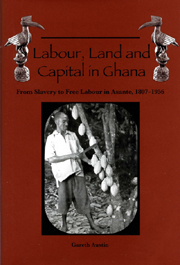Book contents
- Frontmatter
- Contents
- List of Illustrations
- List of Tables
- Preface
- Note on Names
- Maps
- Note on the Maps
- 1 Introduction
- Part I Context and Concepts
- Part II Social Relations of Production and Trade, 1807–1896: Absent and Imperfect Factor Markets
- Part III Slavery as Hobson's Choice: An Analysis of the Interaction of Markets and Coercion in Asante's Era of ‘Legitimate Commerce’, 1807–1896
- 8 Factor Markets Without Free Labour: The Nieboer Hypothesis and Asante Slavery and Pawnship, 1807–1896
- 9 Gender and Kinship Aspects of the Social Relations of Production, 1807–1896
- 10 Exploitation and Welfare: Class and ‘Social Efficiency’ Implications of the Property Rights Regime, 1807–1896
- Part IV The Decline of Coercion in the Factor Markets of Colonial Asante: Cocoa and the Ending of Slavery, Pawnship and Corvée, 1896–c.1950
- Part V Social Relations of Production and Trade, 1908–1956: Towards Integrated Factor Markets?
- Part VI Freedom and Forest Rent, 1908–1956
- Abbreviations Used in the Notes
- Notes
- List of References
- Index
10 - Exploitation and Welfare: Class and ‘Social Efficiency’ Implications of the Property Rights Regime, 1807–1896
from Part III - Slavery as Hobson's Choice: An Analysis of the Interaction of Markets and Coercion in Asante's Era of ‘Legitimate Commerce’, 1807–1896
Published online by Cambridge University Press: 12 September 2012
- Frontmatter
- Contents
- List of Illustrations
- List of Tables
- Preface
- Note on Names
- Maps
- Note on the Maps
- 1 Introduction
- Part I Context and Concepts
- Part II Social Relations of Production and Trade, 1807–1896: Absent and Imperfect Factor Markets
- Part III Slavery as Hobson's Choice: An Analysis of the Interaction of Markets and Coercion in Asante's Era of ‘Legitimate Commerce’, 1807–1896
- 8 Factor Markets Without Free Labour: The Nieboer Hypothesis and Asante Slavery and Pawnship, 1807–1896
- 9 Gender and Kinship Aspects of the Social Relations of Production, 1807–1896
- 10 Exploitation and Welfare: Class and ‘Social Efficiency’ Implications of the Property Rights Regime, 1807–1896
- Part IV The Decline of Coercion in the Factor Markets of Colonial Asante: Cocoa and the Ending of Slavery, Pawnship and Corvée, 1896–c.1950
- Part V Social Relations of Production and Trade, 1908–1956: Towards Integrated Factor Markets?
- Part VI Freedom and Forest Rent, 1908–1956
- Abbreviations Used in the Notes
- Notes
- List of References
- Index
Summary
This chapter explores the implications of the pattern of rights and markets in productive resources for the economic and demographic strategies of individuals—differentiated as they were by rank. Slavery and pawning, as the major means of acquiring extra-familial resources, were crucial to the prospects of demographic and economic accumulation by commoners, and were important also for the wealth of chiefs. Section A relates commoners' and chiefs' acquisition and use of slaves and pawns to their respective patterns of demographic and economic accumulation. Section B reviews the evidence about the degrees and forms of accommodation, resistance and conflict involved in the social relations of production, and reflects on the implications for the evolution of the economy.
Imperfect Markets and Unequal Masters
Those factor markets which existed were highly ‘imperfect’ not only in the sense that they were based partly on coercion, but also in that some of the participants had extra-economic rights which gave them powerful privileges compared to ordinary free commoners (‘free’ in the sense of being neither slaves nor pawns). Thus while the acquisition of more labour was the generic key to expansion, alike for a commoner household or for a major chief, the distribution of specific social categories of labour, such as free wives, pawns and slaves, not to mention the right to corvée, was very unequal even among the free male population. This section examines and compares the options for, and constraints upon, the acquisition of productive resources that faced free commoners and chiefs respectively, and illustrates the paths of accumulation that some of them followed.
- Type
- Chapter
- Information
- Labour, Land and Capital in GhanaFrom Slavery to Free Labour in Asante, 1807–1956, pp. 181 - 202Publisher: Boydell & BrewerPrint publication year: 2005

